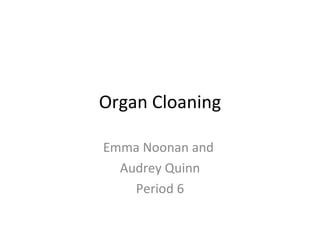
Science project emma&audrey[1]
- 1. Organ Cloaning Emma Noonan and Audrey Quinn Period 6
- 2. Human Genome Project- When did the project start and how did scientists hope to use this information (what were the goals in the beginning)? The human genome project started in 1990 and ended in 2003, two years before scheduled. The initial goals of the human genome project were to understand the genetic makeup of humans, and to study the ethical, legal and social implications. The project also looked at other organisms such as the fruit fly and the mouse. Another goal was to examine and look at 20,000-25,000 genes in human DNA. Finally they wanted to improve tools that are used to analyze data.
- 5. Example of Punnett squares . Parent 1 Parent 2 BB Bb BB BB Bb Bb Phenotypes: Blue eyes-100% Green eyes 0% Genotypes: BB-50% Bb-50% Bb-0%
- 6. Genetic Disorder Single gene disorder is a genetic condition that is caused by the defect of a specific gene in the affects a person ’ s DNA. Single gene disorders are often inherited. Some examples of single gene disorders are cystic fibrosis, sickle cell anemia, Tay-Sachs disease, myotonic dystrophy, Duchenne and Becker muscular dystrophies, Fragile X syndrome and spinal muscular atrophy. Much like single gene disorders chromosome abnormalities it deals with the mutation of DNA. Chromosome abnormalities can be arranged into two basic categories, numerical abnormalities which is when a person does not have a matching chromosome to a pair or has more than two chromosomes. The other group is structural abnormalities which is when the chromosomes structure is changed. Multifactorial disorders is a problem in which it is likely related with the effects of many genes in association with lifestyle and environmental factors. How can genetic counseling help perspective parents who have a genetic disorder regarding future children? It can help you determine the potential risk of having a child with an inherited disorder. How are karyotypes used to predict genetic disorders? Karyotypes are used to predict genetic disorders by looking at the structure of your chromosomes.
- 7. Argument 1- Pro One reason why we are pro for this topic is because if you use your own organ, then your body will not reject that organ. “Some people die even with anti-rejection drugs like Cyclosporine. So what’s the solution? There is one potential remedy that seems to make the most sense despite its potential for extreme controversy and that is cloning.” Explained Bob Aronson. He also says that cloning your own organs would save the patient, the insurance company, and the government more money because they would not have to pay for the anti-resistant drugs. Organ cloning involves growing replacement organs such as a heart, liver, pancreas, or skin from a sample of a persons DNA. This will benefit people who have heart or kidney failure to be able to get a new organ without it being rejected or having to take medication.
- 8. How much money organ cloning costs.
- 9. Argument 2- Pro Another reason why organ cloning is good is that you do not have to wait until an organ is available. You will just go into surgery as quickly as possible, and you will get a clone of your own, and you will not have to worry about how long it takes to find an available organ. “The patient would not have to wait until an unrelated donor dies to obtain a transplant. A new organ could be grown for them as needed. Also, the procedure would save lives which would otherwise be lost waiting for a transplant that did not come in time,“ says B. A. Robinson, along with the Ontario Consultants on Religious Tolerance group.
- 10. Argument 3-Pro A good thing about organ cloning is that there is no surgery required for most organs that are needed. It is duplicated inside the body, and there is no need for the pain, inconvenience of surgery, and other bad things about donating and receiving organs. (Explained by B.A. Robinson).
- 12. Steps of Cloning in sheep
- 13. Conclusion We think that the government should fund money for research on Organ Cloning. If they give money to research organ cloning, many lives can be saved because the organ that they are getting may be life- changing. It would be very helpful if the government would fund money for research so we could learn more about how to advance organ cloning, and also because it could save many lives.
- 14. Works Cited "About the Human Genome Project." Oak Ridge National Laboratory . Web. 21 Mar. 2011. <http://www.ornl.gov/sci/techresources/Human_Genome/project/about.shtml>. "Human Genome Project: a New Reality." The Human Genome Project . Web. 21 Mar. 2011. <http://www.sanger.ac.uk/about/history/hgp/>. Robinson, B. A. "Therapeutic Cloning - How It Is Done; Possible Benefits." ReligiousTolerance.org by the Ontario Consultants on Religious Tolerance . 17 Aug. 2000. Web. 21 Mar. 2011. <http://www.religioustolerance.org/clo_ther.htm>. Aronson, Bob. "Cloned Organs In the Near Future. No Rejection, No Drugs." Transplant Groups . 1 Oct. 2010. Web. 24 Mar. 2011. <http://transplantgroups.ning.com/profiles/blogs/cloned-organs-in-the-near>. Robinson, B. A. "Therapeutic Cloning - How It Is Done; Possible Benefits." ReligiousTolerance.org by the Ontario Consultants on Religious Tolerance . 17 Aug. 2000. Web. 24 Mar. 2011. <http://www.religioustolerance.org/clo_ther.htm>.
Notas do Editor
- B.